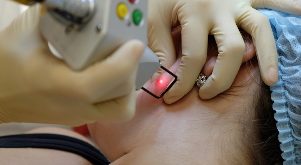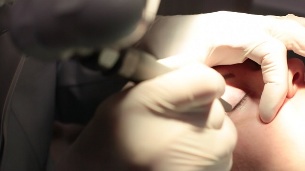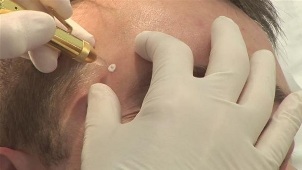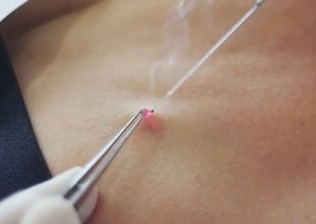
Laser tumor removal is a very popular and effective procedure for removing unwanted tumors. This is a relatively new method, which appeared in the medical arsenal not long ago, but has proved its advantages over other methods of elimination. The precursor to laser destruction is removal with liquid nitrogen, electricity or a scalpel. All of this can cause significant discomfort to the patient, while laser removal results high with painless intervention.
Why delete
Papillomas are tumors of many different shapes and sizes, usually benign. They are localized on the mucous membrane of the wearer or his skin. The main reason for their appearance is due to the human papillomavirus virus activity, which in most cases is sexually transmitted.
Deleting these builds will do multiple tasks at once:
- Beauty correction.A patient with growth may be uncomfortable with being overly focused on them by others. Consequently, a person may feel insecure and irritable, even when the development is not endangering them.
- Injury prevention.If the part that grows in the injured area is frequently touched by the patient, this may result in separation of the protrusion. Also, when trying to cover the papillomas with clothing, problems such as rubbing against the affected area can occur. This results in papilloma lesions and possible subsequent infection. Injury can lead to bacterial penetration, which can cause wound inflammation. If this happens, the damaged area must be treated with peroxide and immediately go to the clinic to remove the remaining papillae.
- Reduces cancer risk.Although the development is benign in nature, many of them manifest as warts. They are often located in intimate places and pose a great danger to the development of cancer. To prevent the disease, all warts must be removed.
Do not manually remove development parts. Any attempt to force a papilloma with a thread, comb, to apply certain chemicals to it may exacerbate its condition.
The benefits of the process
Laser destruction has a number of advantages over other methods of removal.These include:
- Guaranteed results.Thanks to the action of a laser, the hair growth is completely removed, leaving nothing even in the deep layers of the skin. The device can penetrate deep enough to clean any traces of the presence of the tumor.
- No pain.Laser exposure provides minimal pain relief. If you undergo preliminary anesthesia with the local anesthetic on the procedure, there is no pain at all.
- Procedure speed. Laser removal requires 2 to 5 minutes per particle.
- Non-invasive.The laser beam is in a strictly confined region and does not extend beyond it. In this case, many parts of the laser do not touch the process site. This is important, as it minimizes the risk of infection and ensures high sterility.
- No scarring after surgery.If the work is done correctly, there will be no trace of laser impact at the point of contact. This is due to the fact that the affected tissue has evaporated completely and then new intact skin is replaced.
- How to erase doesn't take blood.The laser beam heats the blood-supplying capillaries, quickly sealing their walls. As a result, bleeding stops and does not resume after surgery.
- Suitable for different body parts.Not all methods of removal may be used on every part of the body. Intimate places, eyelids, . . . considered particularly sensitive. Laser destruction does a good job of coping with developments in such areas due to the precision of the laser beam.
All of these factors make laser hair removal one of the most sought-after treatments for hair removal.
Contraindications
The list of contraindications to this trick is not as long as other destruction methods.Among laser removal bans:
- diabetes mellitus;
- oncology;
- exacerbations of chronic diseases;
- epilepsy;
- diseases related to the endocrine system;
- poor blood clotting;
- HIV or AIDS;
- acute inflammatory diseases.
In addition, patients who have recently had influenza or an acute respiratory infection should also delay the procedure for a while.
Procedure description
Before starting any procedure to remove tumors, your doctor will disinfect the area to be operated on. In some cases, local anesthetic analgesia is used. Usually, ointments or sprays are used for this. After applying the anesthetic, 2-3 minutes pass and the elimination process begins.

The laser beam is directed at the affected area and as it stifles unwanted growth. At this point, the contents of the cells are evaporated under the action of the laser, removing each layer of affected tissue. This doesn't just happen in accessible places in open spaces. The procedure for removing papillomas, for example, on the eyelids, is the same. The only nuance in this area is a special cooling method used so that the patient does not experience pain and burns in this sensitive spot.
Neoplasms in intimate places are removed according to the same principle. But here doctors often use the method of anesthetic injection, anesthesia, injection from many different sides.
At the moment of puncture may be a bit painful, but after a few minutes the sensitivity of the affected area completely disappears and subsequent operations are completely painless.
Affected area turns into a small wound with no blood. At the time of destruction, it is disinfected due to laser action. After removing the accumulation, the doctor will treat the affected area with purple medicine.
Once done, the patient may experience mild redness, itching, or mild pain at the site of the papilla removal.
This reaction is considered normal, because, although not invasive of the procedure, during the procedure there has been an intervention in the integrity of the skin.Any discomfort should completely go away 2-4 days after the procedure.
A dry scaly layer then appears on the wound. Beneath it is an already healthy layer of skin, so its protective crust cannot be torn off until it comes off on its own. If not, the scar may remain on the skin and recovery may take longer.
The aftermath
Complications after laser destruction are rare. As a rule, their presence is related to diseases the patient has had that he had not cured prior to the procedure. So, for example, if the patient has dermatitis, it can contribute to the appearance of pigmentation. If the skin itself is very sensitive, there may be a slight reddening of the burn. With a high allergic reaction, edema may occur at the site of contact.
To rule out any undesirable consequences, it is necessary to consult a doctor before proceeding with laser destruction.
Post-Process Care
After removing the accumulator, the patient must adhere to the following rules:
- do not let water into the wound for 2-3 days;
- is limited to saunas, tubs and swimming pools;
- do not rub the damaged area with a towel;
- does not use adhesives on the wound;
- does not treat the papilloma removal site with an exfoliating agent or lotion containing alcohol;
- avoids exposure to ultraviolet rays.
Several times a day, it is necessary to disinfect the wound. This must be done until the scabs are removed. This treatment will prevent infection and help speed up the complete healing time.To treat the damaged area you can use iodine or a solution of violet.
After removal, it is possible to treat with anti-inflammatory ointment.
Their actions are aimed at accelerating tissue regeneration, reducing inflammation and edema. Before choosing a specific remedy, it's best to consult your doctor.
Which method is better
Laser removal is not the only way to cope with unwanted growth. There are also other ways, among which stand out:

Cryodestruction.
Based on papillae removal with liquid nitrogen. Due to the exposure to low temperatures, the accumulation layer begins to collapse and eventually disappears completely. This method is effective, but has a number of drawbacks. Among them, the depth of action of nitrogen cannot be completely controlled. This substance can pass very deep, touch the healthy region or vice versa, affect only the superficial, without affecting all localized layers of the structure.
Also, this method is characterized by:
- likely to have scarring after surgery;
- painful feeling;
- cannot guarantee results after the first procedure.
Hence, laser destruction showed higher efficiency than cold destruction. Laser removal is less painful and is more likely to guarantee the desired results.
Removes radio waves.
This method of destruction is done with a special device that affects the papilloma through radio waves. This promotes the elimination of the buildup caused by the radio knife's point action. The accuracy of the procedure is very high, so nearby tissues are not affected. However, the risk of burns or infection is extremely low.
This method is suitable for the removal of small benign lesions. It is highly effective, making it as ubiquitous as laser destruction. Both methods are considered modern approaches to papilla removal and are used equally well in medicine.

Coagulation of capacitors.
This method is based on the action of the high-frequency electric current to the papilloma directly at the site of the lesion. Capacitor coagulation is now considered a popular but outdated method. This method allows you to prevent bleeding after removing the papilloma by burning the vessels.
However, when using high frequency currents, the patient feels pain even under anesthesia. This has led some patients to give up electrocautery, opting for laser ablation as a more advanced and painless method.
Estimated cost
The price range is not only dependent on the area and clinic performing the removal, but also on the number, size and location of tumors to be removed.
In many clinics there is a discount on mass removal of new tumors: the more a patient has, the cheaper it will be to remove a new tumor.
Removing a tumor from the genitals can be significantly more expensive than other parts of the body. Furthermore, not all clinics offer such a service due to the complexity of such an operation.














































































